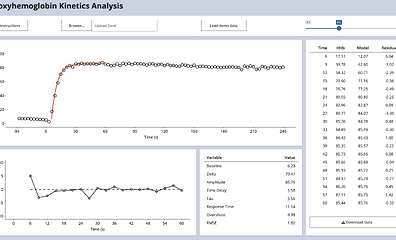Deoxyhemoglobin Kinetics Analysis
Authors: Tim Fulton
Abstract: This app performs kinetic modeling of deoxyhemoglobin (HHb) data obtained using near-infrared spectroscopy. The metrics that are calculated provide estimates of microvascular function during the transition from rest to exercise.
Full Description:
Background
This app performs kinetic modeling of deoxyhemoglobin (HHb) data obtained using near-infrared spectroscopy. The metrics that are calculated provide estimates of microvascular function during the transition from rest to exercise.
Methods
The data are fit using a monoexponential model with a time delay according to the equation below:
where HHb is the HHb at any time t, baseline HHb is the average HHb during the 30 seconds of rest prior to exercise, delta HHb is the difference between the baseline and the steady state amplitude at 60 seconds, t is the time, TD is the time delay, and tau is the time taken to reach 63% of the steady state amplitude.
Three additional variables that are calculated are:
- Response Time - The sum of the time delay and the tau.
- Overshoot - The difference between the amplitude and the average HHb over the final 15 seconds of exercise.
- RMSE - The root mean squared error of the fit.
The timespan of the data used will range from the first fitting point to 60 seconds.
Usage
Uppload darta using the browse button (visitors can use the demo data). The first fitting point defaults to 6 seconds, but it should be adjusted to the first data point after time zero (exercise start) that is higher than the baseline. The first fitting point can be adjusted using the slider on the right.
Shiny app: HHb Kinetics
Repo: GitHub - timfulton1/hhb_shiny_app: Deoxyhemoglobin Kinetic Modeling App
Thumbnail:
